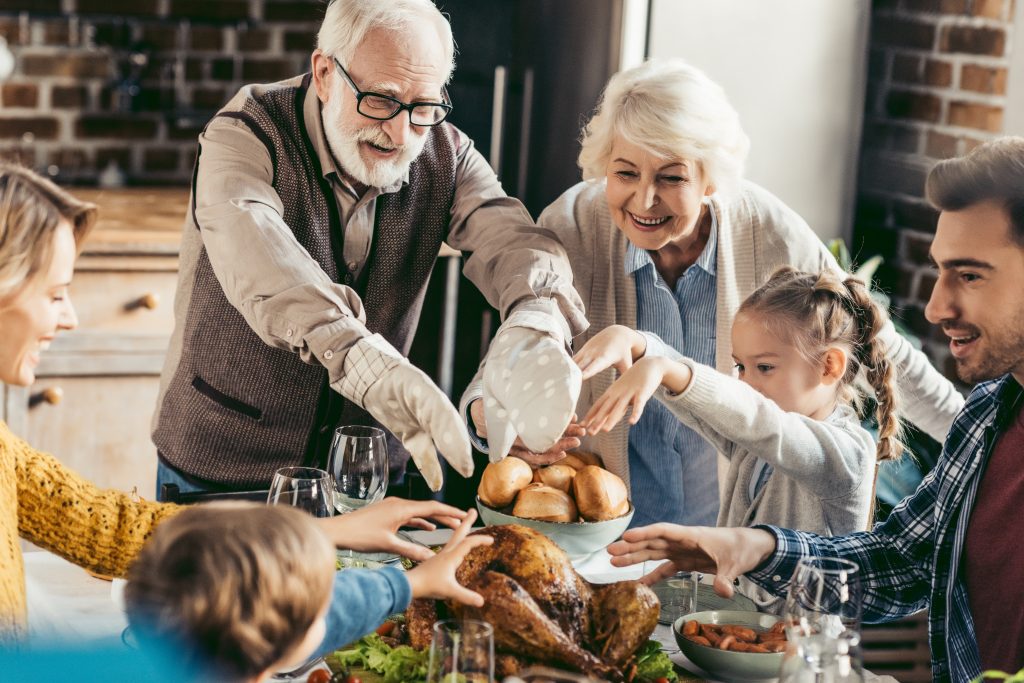Thanksgiving Day is observed each year in the United States on the fourth Thursday in November.
In 1621, the Plymouth colonists and Wampanoag Indians shared an autumn harvest feast that is acknowledged today as one of the first Thanksgiving celebrations in the colonies. For more than two centuries, days of thanksgiving were celebrated by individual colonies and states. It wasn’t until 1863, amid the Civil War, that President Abraham Lincoln proclaimed a national Thanksgiving Day to be held each November.
In many American households, the Thanksgiving celebration has lost much of its original religious significance; instead, it now centers on cooking and sharing a bountiful meal with family and friends. Turkey, a Thanksgiving staple so ubiquitous it has become all but synonymous with the holiday, may or may not have been on offer when the Pilgrims hosted the inaugural feast in 1621. Today, however, nearly 90 percent of Americans eat the bird—whether roasted, baked, or deep-fried—on Thanksgiving, according to the National Turkey Federation. Other traditional foods include stuffing, mashed potatoes, cranberry sauce, and pumpkin pie. Volunteering is a common Thanksgiving Day activity. Communities often hold food drives and host free dinners for the less fortunate.
Parades have also become an integral part of the holiday in cities and towns across the United States. Presented by Macy’s department store since 1924, New York City’s Thanksgiving Day parade is the largest and most famous, attracting some 2 to 3 million spectators along its 2.5-mile route and drawing an enormous television audience. It typically features marching bands, performers, elaborate floats conveying various celebrities, and giant balloons shaped like cartoon characters.
Beginning in the mid-20th century and perhaps even earlier, the president of the United States has “pardoned” one or two Thanksgiving turkeys each year, sparing the birds from slaughter and sending them to a farm for retirement. Several U.S. governors also perform the annual turkey pardoning ritual.
Use #ThanksgivingDay to post on social media.
THANKSGIVING DAY HISTORY
Plymouth
In September 1620, a small ship called the Mayflower left Plymouth, England. The ship carried 102 passengers—an assortment of religious separatists seeking a new home where they could freely practice their faith and other individuals lured by the promise of prosperity and land ownership in the New World. After a treacherous and uncomfortable crossing that lasted 66 days, they dropped anchor near the tip of Cape Cod, far north of their intended destination at the mouth of the Hudson River. One month later, the Mayflower crossed Massachusetts Bay, where the Pilgrims, as they are now commonly known, began the work of establishing a village at Plymouth.
Throughout that first brutal winter, most of the colonists remained on board the ship. They suffered from exposure, scurvy, and outbreaks of contagious diseases. Only half of the Mayflower’s original passengers and crew lived. When the remaining settlers moved ashore in March, they received an astonishing visit. An Abenaki Indian greeted them in English. Several days later, he returned with another Native American named Squanto.
Squanto was a member of the Pawtuxet tribe, had been kidnapped by an English sea captain and sold into slavery before escaping to London and returning to his homeland on an exploratory expedition. Squanto taught the Pilgrims, weakened by malnutrition and illness, how to cultivate corn, extract sap from maple trees, catch fish in the rivers and avoid poisonous plants. He also helped the settlers forge an alliance with the Wampanoag, a local tribe. The alliance would endure for more than 50 years, and tragically remains one of the sole examples of harmony between European colonists and Native Americans.
First Thanksgiving
In November 1621, after the first successful corn harvest, Governor William Bradford organized a celebratory feast. He invited a group of the fledgling colony’s Native American allies, including the Wampanoag chief Massasoit. Now remembered as American’s “first Thanksgiving”—although the Pilgrims themselves may not have used the term at the time—the festival lasted for three days. While no record exists of the historic banquet’s menu, the Pilgrim chronicler Edward Winslow wrote in his journal that Governor Bradford sent four men on a “fowling” mission in preparation for the event and that the Wampanoag guests arrived bearing five deer. Historians suggest that many of the dishes likely used traditional Native American spices and cooking methods. Because the Pilgrims had no oven and the Mayflower’s sugar supply had dwindled by the fall of 1621, the meal did not feature pies, cakes, or other desserts, which have become a hallmark of contemporary celebrations.
This history of Thanksgiving provided by www.History.com. For more information on Thanksgiving, go to http://www.history.com/topics/thanksgiving/history-of-thanksgiving.
The Next Thanksgivings
Pilgrims held their second Thanksgiving celebration in 1623 to mark the end of a long drought that had threatened the year’s harvest and prompted Governor Bradford to call for a religious fast. Days of fasting and thanksgiving on an annual or occasional basis became common practice in other New England settlements as well. During the American Revolution, the Continental Congress designated one or more days of thanksgiving a year. In 1789 George Washington issued the first Thanksgiving proclamation by the national government of the United States; in it, he called upon Americans to express their gratitude for the happy conclusion to the country’s war of independence and the successful ratification of the U.S. Constitution. His successors John Adams and James Madison also designated days of thanks during their presidencies.
In 1817, New York became the first of several states to adopt an annual Thanksgiving holiday officially; each celebrated it on a different day, however, and the American South remained largely unfamiliar with the tradition.
National Observance
In 1827, the noted magazine editor and prolific writer Sarah Josepha Hale—author, among countless other things, of the nursery rhyme “Mary Had a Little Lamb”—launched a campaign to establish Thanksgiving as a national holiday. For 36 years, she published numerous editorials. The editor sent scores of letters to governors, senators, presidents, and other politicians.
At the height of the Civil War in 1863, Abraham Lincoln finally heeded her request. In a proclamation, he entreated all Americans to ask God to “commend to his tender care all those who have become widows, orphans, mourners or sufferers in the lamentable civil strife” and to “heal the wounds of the nation.” President Lincoln scheduled Thanksgiving for the final Thursday in November. It was celebrated on that day every year until 1939 when Franklin D. Roosevelt moved the holiday up a week in an attempt to spur retail sales during the Great Depression. Roosevelt’s plan, known derisively as Franksgiving, was met with passionate opposition. In 1941, the president reluctantly signed a bill making Thanksgiving the fourth Thursday in November.



